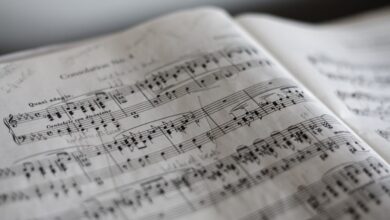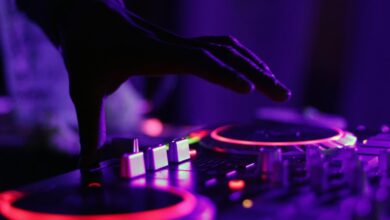The Influence of Technology on Music Composition and Performance

Have you ever wondered how technology has transformed the world of music? From the way we compose melodies to the way we perform them, technology has made a profound impact. In this article, we’ll explore the fascinating realm where technology and music intersect, uncovering the ways it has revolutionized both composition and performance.
When it comes to music composition, technology has opened up a whole new world of possibilities. Gone are the days when composers were limited to pen and paper. With the advent of computer software and digital audio workstations (DAWs), musicians can now effortlessly experiment with different sounds, instruments, and arrangements. These tools provide composers with a vast array of virtual instruments, allowing them to create music that would have been unimaginable just a few decades ago. Whether it’s orchestral compositions, electronic beats, or experimental soundscapes, technology has given composers the freedom to explore their creative boundaries like never before.
Moreover, technology has also facilitated collaboration among musicians. With the rise of the internet and cloud-based platforms, musicians from different parts of the world can now connect and work together seamlessly. They can share project files, exchange ideas, and even record their parts remotely. This interconnectedness has not only fostered a sense of global musical community but has also allowed for the creation of unique cross-cultural compositions that blend diverse styles and traditions.
In terms of performance, technology has brought about groundbreaking advancements. The integration of MIDI (Musical Instrument Digital Interface) technology has enabled musicians to control and manipulate electronic instruments and synthesizers with precision. This has led to the development of entirely new genres and styles of music, such as electronic dance music (EDM) and hip-hop, which heavily rely on synthesized sounds and sampled beats.

Furthermore, live performances have been elevated through the incorporation of technology. From elaborate light shows synced to music, projection mapping onto stages, to immersive virtual reality experiences, technology has transformed the way audiences engage with music during live concerts. It has allowed musicians to create unforgettable visual spectacles that complement their sonic artistry, captivating audiences in ways unimaginable in the past.
Technological Innovations Revolutionize Music Composition: From AI Composers to Virtual Instruments

With the rapid advancement of technology, the field of music composition has undergone a transformative revolution. Today, we find ourselves at the intersection of artificial intelligence and music, witnessing groundbreaking innovations that are reshaping the way music is created and experienced. From AI composers to virtual instruments, these technological marvels are pushing the boundaries of creativity and opening up new avenues for musicians and composers alike.
Imagine a world where melodies are born within lines of code, where algorithms analyze patterns and emotions to generate breathtaking compositions. This seemingly futuristic concept is now a reality, thanks to AI composers. These intelligent systems can analyze vast amounts of musical data, learn from it, and compose original pieces that captivate listeners. Whether it’s classical symphonies or contemporary pop tunes, AI composers have the ability to mimic various styles and create music that stirs the soul.
Furthermore, virtual instruments have revolutionized the way musicians interact with their craft. Gone are the days when one had to purchase expensive physical instruments to produce high-quality music. Virtual instruments allow musicians to recreate the sounds of countless instruments through software, transforming a simple computer into a complete orchestra. From realistic piano notes to thunderous drum beats, these digital wonders provide an unprecedented level of flexibility and convenience.
But what about the human touch? Can technology truly replace the creative intuition and emotion that comes from a human composer? While AI composers and virtual instruments offer incredible possibilities, they should be viewed as tools rather than replacements. When wielded by skilled musicians and composers, these technologies become extensions of their artistic expression, enabling them to explore uncharted territories and push the boundaries of musical innovation.
Technological innovations have brought us to the dawn of a new era in music composition. AI composers and virtual instruments have forever changed the landscape, offering endless possibilities for musicians and composers to explore. As we embrace these advancements, it is crucial to remember that technology should be seen as a partner rather than a competitor in the creative process. By combining human ingenuity with the power of technology, we can unlock new realms of musical brilliance and continue to amaze audiences worldwide.
Unleashing Creativity: How Technology Empowers Musicians in Composition and Performance
Are you a musician looking to take your creative journey to new heights? Look no further than the power of technology. In today’s digital age, musicians have access to an array of tools and resources that can revolutionize their composition and performance capabilities. From music production software to innovative instruments, technology is unlocking a world of possibilities for musicians across the globe.
When it comes to composition, technology serves as a limitless wellspring of inspiration. Gone are the days of being confined to a traditional studio setup. With just a laptop and suitable software, musicians can create entire symphonies from the comfort of their own homes. Digital audio workstations (DAWs) provide a versatile platform for composing and arranging music, allowing artists to experiment with different sounds, effects, and instruments at their fingertips.
Moreover, technology has broken down geographical barriers, enabling collaboration among musicians from diverse backgrounds. Through online platforms and cloud-based services, artists can share their works-in-progress and collaborate in real-time, regardless of their physical location. This fosters a global community of creators, spurring the exchange of ideas and pushing the boundaries of musical innovation.
In the realm of performance, technology has transformed the way musicians engage with audiences. Take, for instance, electronic instruments and MIDI controllers. These futuristic devices allow performers to manipulate sound in ways never before possible. With a simple touch or gesture, musicians can trigger samples, modify tones, and create immersive sonic landscapes, adding an extra layer of expression to their live performances.

Furthermore, advancements in music production have paved the way for breathtaking visual experiences accompanying musical performances. High-definition projections, synchronized lighting, and interactive stage setups create a multisensory extravaganza, captivating audiences and elevating the overall impact of a musical performance.
Technology has become an invaluable ally for musicians seeking to unleash their creativity. It offers a vast array of tools, platforms, and possibilities that empower artists in both composition and performance. By harnessing the power of technology, musicians can transcend traditional boundaries, collaborate globally, and create truly awe-inspiring musical experiences. So, embrace technology as your partner on this creative journey and unlock the boundless potential that awaits you.
From Studio to Stage: Harnessing the Power of Tech for Seamless Music Production and Live Performances
Are you ready to embark on a thrilling journey into the world of music production and live performances? Prepare to be amazed as we delve into the seamless integration of technology that has revolutionized the way artists take their sound from the studio to the stage. In this article, we will explore how musicians are harnessing the power of tech to create unforgettable experiences for their audiences.

Imagine a world where every note, every beat, and every emotion can be captured with pristine precision in the studio, and effortlessly translated onto the stage. Thanks to advancements in music production technology, this dream has become a reality. Gone are the days of lugging around bulky equipment and spending hours setting up before a performance. With state-of-the-art software, virtual instruments, and compact hardware, musicians now have the tools to create and perform with unparalleled ease.
One of the key elements that drives this seamless transition is digital audio workstations (DAWs). These powerful software applications allow artists to record, edit, and mix their tracks with remarkable flexibility. Whether it’s fine-tuning the vocals, adding layers of rich harmonies, or experimenting with different sound effects, DAWs provide an intuitive interface for unleashing creative potential.
But what about the live aspect of music? How can technology enhance the energy and excitement of a live performance? Enter the world of MIDI controllers and electronic instruments. These innovative devices bridge the gap between traditional instruments and modern technology, empowering performers to bring studio-quality sounds to the stage. From MIDI keyboards that trigger virtual instruments to drum pads that effortlessly recreate complex rhythms, these tools amplify the possibilities for live musicians.
Furthermore, advancements in audio processing technology have paved the way for immersive live experiences. Through the use of digital signal processors (DSPs) and sophisticated mixing consoles, artists can shape the sound of their performances in real-time. They can apply effects, adjust levels, and even alter the acoustics of a venue, all with a few taps and twists. This not only enhances the sonic quality but also allows for adaptability and spontaneity during live shows.
The integration of technology in music production and live performances has opened up a world of possibilities for artists. The seamless transition from studio to stage is now within reach, offering musicians the freedom to create, experiment, and captivate audiences like never before. So, whether you’re a music lover or a budding artist, embrace the power of tech and get ready to be swept away by the magic of music.
Breaking Barriers: How Technology Transforms Traditional Music Composition Methods
Introduction:
Have you ever wondered how technology has revolutionized the way music is composed? In this article, we will explore how innovative technologies have broken long-standing barriers in traditional music composition methods. From digital audio workstations to virtual instruments, musicians and composers now have an array of tools at their disposal to create awe-inspiring musical masterpieces.

Embracing Digital Audio Workstations (DAWs):
Gone are the days when composers had to rely solely on pen and paper to jot down their musical ideas. With the advent of Digital Audio Workstations (DAWs), composing music has become more accessible than ever. DAWs allow musicians to record, edit, and arrange music using a computer. Whether it’s capturing live performances or experimenting with different instrument sounds, DAWs offer unparalleled flexibility and efficiency.
Unleashing the Power of Virtual Instruments:
In the past, composers often relied on physical instruments to bring their compositions to life. However, the emergence of virtual instruments has transformed this process. By leveraging advanced software algorithms, virtual instruments mimic the sounds of various instruments, ranging from grand pianos to orchestral strings. Composers can now experiment with different timbres and textures, expanding their creative horizons.
Seamless Collaboration through Cloud-Based Platforms:
Traditionally, collaboration among composers and musicians involved face-to-face meetings and physical sheet music exchanges. Today, cloud-based platforms have revolutionized this aspect of music composition. Through these platforms, composers can effortlessly share their compositions with collaborators around the world in real-time. This not only fosters greater creativity but also allows for seamless integration of diverse musical influences.
Harnessing Artificial Intelligence (AI) in Composition:
Artificial Intelligence (AI) has taken the music industry by storm, enabling groundbreaking advancements in music composition. AI-powered algorithms can analyze vast amounts of musical data to generate original compositions or assist composers in creating harmonies and melodies. This fusion of human creativity and AI’s computational power has opened up new frontiers, sparking innovative and unheard-of musical ideas.
Conclusion:
As technology continues to evolve, so does the realm of music composition. The marriage of traditional music composition methods and cutting-edge technologies has broken barriers, empowering musicians to explore uncharted territories of creativity. From digital audio workstations to virtual instruments, cloud-based collaboration platforms to AI-powered composition tools, technology has undoubtedly transformed the way music is composed, pushing the boundaries of artistic expression further than ever before.




